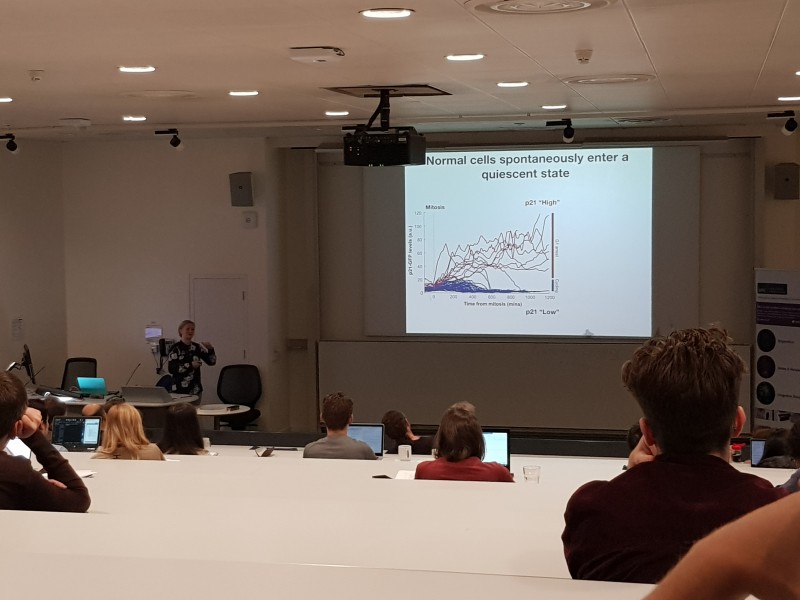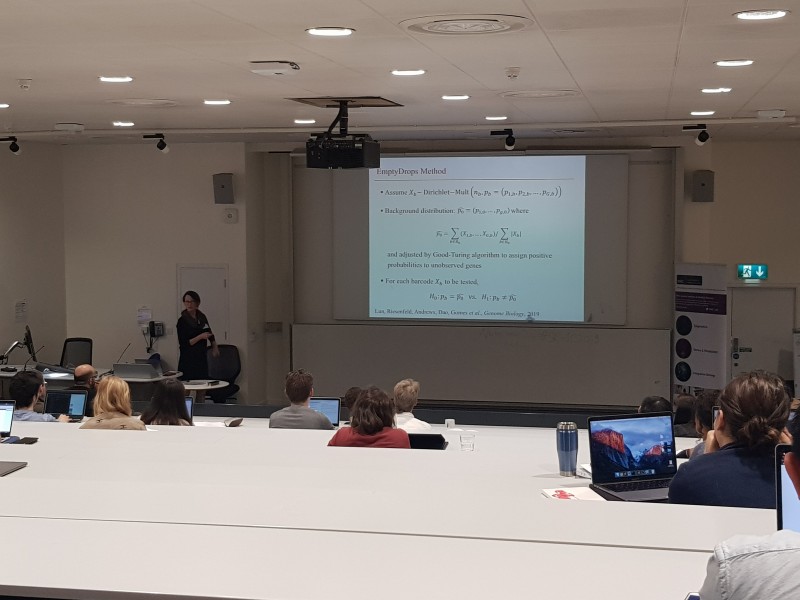By Sophie Arthur
July 8, 2019
Time to read: 4 minutes
From 17-19 June, the Department of Mathematics at Imperial College London hosted our international workshop: “Single-cell data in space and time: mathematical and computational challenges”. The event was co-sponsored by Imperial College Mathematics Quantitative Sciences Research Institute, the EPSRC Centre for Mathematics of Precision Healthcare and the MRC London Institute of Medical Sciences. The meeting brought together over 120 attendees, 26 speakers and 12 poster presentations coming from several continents in a friendly and relaxed atmosphere.
The organisers’ vision was to bring together top researchers from the three areas of single cell research: Technology, Theory and Biology. This led to three days of exciting discussions from researchers from a variety of disciplines but with a common interest in looking at life ‘one cell at a time’.
Technological advancements
Single cell RNA sequencing platforms, which provide the RNA expression profiles of individual cells rather than the average across a population of cells, are increasing in throughput revealing an extremely rich diversity of transcriptional programmes within a group of cells. This leads to a better understanding of tissue heterogeneity – the differences between each cell found in that tissue – and architecture. However, it also raises the question of how many true cell types exist and whether some heterogeneity results from more transient cellular states as cells switch from one identity to another. This also poses the question of how much of a cell state is encoded by all the RNA transcripts comprised in its transcriptome and how much results from post-transcriptional events, such as the activity of different signalling pathways or modifications to the RNA or protein.

Theoretical challenges
These conundrums lead to a series of theoretical challenges that were discussed during the meeting. How to identify real cells from contaminants as the throughput of sequencing platforms increases? Whether and how to impute missing values typical from single cell RNA sequencing data due to the small amount of material available in each cell? How to partition high-dimensions single cell datasets into functionally meaningful clusters in an unsupervised manner. Bringing an estimate of time ordering, or rather pseudo-time, into the analysis helps to connect and define better the transcriptome diversity and plasticity of single cells to more fully understand how and when each cell transitions from one identity to the next. Interesting challenges were discussed including how to compare and contrast single cell trajectories in pseudo-time.
By design, this workshop wanted to explore current efforts to add spatial information to single cell analysis. The picture that emerged at the meeting was mind blowing. On one hand, spatial transcriptomics approaches have now reached (sub)single-cell resolution. On the other hand, imaging approaches, such as in situ hybridisation – a technique used to localise a specific RNA transcript in a tissue, are almost able to probe full transcriptomes of individual cells. At a different level, time-lapse imaging approaches can produce a wealth of data on cellular phenotypes, such as size and growth rate, that when combined with gene expression data produces strong datasets. These are signs of a new era of biological research where histology, transcriptomics and high dimensional phenotyping will merge. This generates new theoretical challenges in particular in terms of data normalisation and integration, single cell transcriptome deconvolution and automated image analysis, which remain computationally very expensive. Finally, these new technologies raise the exciting opportunity to connect transcriptomics signatures to tissue features in health and disease, possibly using artificial intelligence approaches, opening the way to future unsupervised transcriptomic based pathological assessment in the clinic.

Exploring the biological problems
Another important vision of the meeting was to programme shorter talks focusing on the biological problems that can be tackled using single-cell technologies. This brought yet another stimulating angle to the discussions. We heard in particular about the plasticity of cell identity in response to injury, DNA damage, developmental signals, and heterogeneity in bacterial growth inside single immune cells.
Overall, the blend of theory and biology of the workshop managed to bring communities together and led to a very stimulating three days. The generosity of our funders allowed us to organise a BBQ dinner and poster session, with abundant insightful discussions. We finally would like to thank once again everyone who helped us here in London and all the speakers without whom this event would not have been possible.